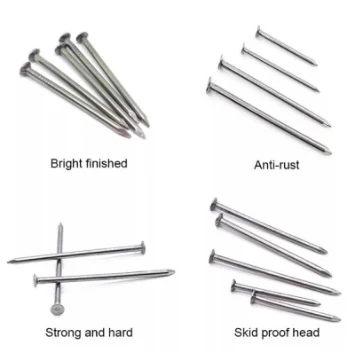nails for treated lumber
Choosing the Right Nails for Treated Lumber
When it comes to building structures with treated lumber, selecting the right fasteners is crucial for both the durability of the project and the longevity of the materials used. Treated lumber, which is wood that has been infused with chemical preservatives to protect against rot, insects, and decay, presents unique challenges that must be addressed in the construction process. This article will explore the importance of using the correct nails, the types of fasteners suitable for treated lumber, and some best practices for installation.
Understanding Treated Lumber
Treated lumber is commonly used in outdoor projects such as decks, fences, and landscaping features due to its ability to withstand harsh environmental conditions. The treatment process often involves pressure-treating wood with chemicals like copper azole (CA), alkaline copper quat (ACQ), or micronized copper. While these treatments are effective in preserving the integrity of the wood, they can also corrode certain types of metals, making the choice of fasteners critical for the success of any project.
The Importance of Using Proper Fasteners
Using improper nails with treated lumber can lead to a variety of issues. The most significant risk is corrosion, which can weaken the bond between the nail and the wood over time and ultimately compromise the structural integrity of the construction. Additionally, using nails that are not designed to withstand the chemicals in treated lumber can lead to premature failure, resulting in safety hazards and costly repairs.
Types of Nails Suitable for Treated Lumber
When selecting nails for treated lumber, it is essential to choose fasteners that are specifically designed to resist corrosion. Here are some recommended types
1. Hot-Dipped Galvanized Nails This is one of the most popular choices for treated lumber. These nails are coated with a thick layer of zinc, which provides excellent corrosion resistance. They are suitable for both interior and exterior applications.
2. Stainless Steel Nails For projects exposed to harsh environments, stainless steel nails are a top choice. They offer the highest resistance to corrosion and are ideal for coastal areas or places with high humidity.
nails for treated lumber

3. Coated Decking Screws While screws are not nails, it’s worth mentioning that many builders prefer using coated decking screws specifically designed for treated lumber. These screws provide a stronger hold than nails and are less prone to popping out over time, enhancing the longevity of constructions.
Best Practices for Installation
When working with treated lumber and the appropriate fasteners, consider the following best practices to ensure a successful outcome
- Pre-Drilling For large diameter nails or in dense wood, pre-drilling holes can help reduce the risk of splitting, which is particularly relevant for treated lumber due to its density.
- Proper Placement Follow local building codes and guidelines for nail placement, including the spaces between fasteners, as this can impact the strength and integrity of the structure.
- Use Appropriate Length Make sure the nails or screws you use are long enough to securely penetrate the treated lumber and reach the underlying structure, typically by at least 1.5 times the thickness of the lumber.
- Avoid Overdriving Be cautious not to overdrive the nails, as this can weaken the fastener's hold and create a structural vulnerability.
Conclusion
Choosing the right nails for treated lumber is a vital step in any construction project involving outdoor applications. The potential for corrosion and decay necessitates the use of fasteners designed specifically for interaction with treated wood. By selecting hot-dipped galvanized, stainless steel, or suitable coated screws, and by adhering to best practices during installation, builders can ensure the durability and safety of their structures for years to come. Whether building a beautiful deck, a sturdy fence, or unique landscaping features, the right choice of fasteners will contribute immensely to the project's success.
-
Space-Saving Chain Fence Hacks Vertical Gardening with Cyclone MeshNewsJul.16,2025
-
Innovations in Iron Nail Wire Production for Modern ConstructionNewsJul.16,2025
-
Creative Uses of Wire Netting Fence in Modern Landscape DesignNewsJul.16,2025
-
Barbed Wire Fence Innovations in Anti-Climb TechnologyNewsJul.16,2025
-
Architectural Uses of Umbrella Nails for Aesthetic Roof DesignsNewsJul.16,2025
-
Architectural Uses of Razor Barbed Wire in Secure Urban DesignNewsJul.16,2025




